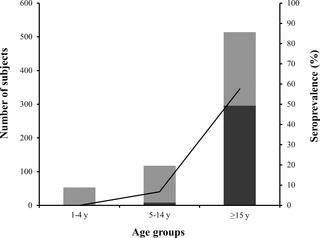当前位置:
X-MOL 学术
›
PLOS Negl. Trop. Dis.
›
论文详情
Our official English website, www.x-mol.net, welcomes your feedback! (Note: you will need to create a separate account there.)
Use of rapid diagnostic tests (RDTs) for conclusive diagnosis of chronic Chagas disease - field implementation in the Bolivian Chaco region.
PLOS Neglected Tropical Diseases ( IF 3.8 ) Pub Date : 2019-12-19 , DOI: 10.1371/journal.pntd.0007877 Daniel Lozano 1, 2 , Lizeth Rojas 1 , Susana Méndez 3 , Aina Casellas 3 , Sergi Sanz 3 , Lourdes Ortiz 4 , María Jesús Pinazo 3 , Marcelo Abril 5 , Joaquim Gascón 3 , Faustino Torrico 1, 2 , Julio Alonso-Padilla 3
PLOS Neglected Tropical Diseases ( IF 3.8 ) Pub Date : 2019-12-19 , DOI: 10.1371/journal.pntd.0007877 Daniel Lozano 1, 2 , Lizeth Rojas 1 , Susana Méndez 3 , Aina Casellas 3 , Sergi Sanz 3 , Lourdes Ortiz 4 , María Jesús Pinazo 3 , Marcelo Abril 5 , Joaquim Gascón 3 , Faustino Torrico 1, 2 , Julio Alonso-Padilla 3
Affiliation

|
Chagas disease, caused by the parasite Trypanosoma cruzi, is the neglected tropical disease with a highest burden in Latin America. Its acute stage is mostly asymptomatic and goes unnoticed. Symptoms appear at the chronic stage, which is when diagnosis is usually made. This is based on the agreement of two conventional serological tests such as Enzyme-Linked Immunosorbent Assays (ELISAs). There are commercial kits with good sensitivity and specificity but their use is impractical in many highly endemic regions with poorly equipped laboratories. Luckily, several rapid diagnostic tests (RDTs) are available for the detection of anti-T. cruzi immunoglobulins. They are easy to operate, require no cold storage, provide fast turnaround of results, and some can work with a tiny volume of whole blood as sample. With the aim to field validate their use we compared an alternative algorithm based on a combination of RDTs with the standard based on ELISAs. In both cases a third test was available in case of discordance. RDTs were implemented by mobile teams in field campaigns to detect chronic T. cruzi-infections in the Chaco region of Bolivia. ELISAs were made in the reference laboratories located in the main hospitals of Yacuiba and Villa Montes, two major cities of the region. We enrolled 685 subjects who voluntarily participated in the study and had not been treated against the disease before. The agreement between the two main RDTs was 93.1% (638/685) (kappa index = 0.86; CI 95% 0.83-0.90). In comparison to the ELISAs algorithm, the combined use of the RDTs provided a sensitivity of 97.7% and a specificity of 96.1%. These results support the use of RDTs for the diagnosis of chronic Chagas disease in the studied region, and encourage their evaluation in other regions of Bolivia and other endemic countries.
中文翻译:

使用快速诊断测试(RDT)最终诊断慢性南美锥虫病-玻利维亚Chaco地区的现场实施。
由寄生虫克氏锥虫引起的南美锥虫病是拉丁美洲被忽视的热带疾病,负担最重。它的急性期主要是无症状的,没有引起注意。症状出现在慢性阶段,通常是在进行诊断时。这是基于两种常规血清学测试(例如酶联免疫吸附测定(ELISA))的协议。有一些商业试剂盒具有良好的敏感性和特异性,但在实验室装备差的许多高流行地区使用它们是不切实际的。幸运的是,有几种快速诊断测试(RDT)可用于检测抗T。克鲁兹免疫球蛋白。它们易于操作,无需冷藏,提供快速的结果周转服务,并且某些样品可以处理极少量的全血。为了现场验证其用途,我们将基于RDT的替代算法与基于ELISA的标准进行了比较。在这两种情况下,如果出现不一致情况,都可以进行第三次测试。流动小组在野外活动中实施了RDT,以检测玻利维亚Chaco地区的慢性克鲁氏锥虫感染。在该地区两个主要城市Yacuiba和Villa Montes的主要医院的参考实验室中进行了ELISA。我们招募了685名自愿参加该研究且之前未接受过针对该疾病的治疗的受试者。两个主要RDT之间的一致性为93.1%(638/685)(kappa指数= 0.86; CI 95%0.83-0.90)。与ELISAs算法相比,RDT的组合使用可提供97.7%的灵敏度和96.1%的特异性。
更新日期:2019-12-20
中文翻译:

使用快速诊断测试(RDT)最终诊断慢性南美锥虫病-玻利维亚Chaco地区的现场实施。
由寄生虫克氏锥虫引起的南美锥虫病是拉丁美洲被忽视的热带疾病,负担最重。它的急性期主要是无症状的,没有引起注意。症状出现在慢性阶段,通常是在进行诊断时。这是基于两种常规血清学测试(例如酶联免疫吸附测定(ELISA))的协议。有一些商业试剂盒具有良好的敏感性和特异性,但在实验室装备差的许多高流行地区使用它们是不切实际的。幸运的是,有几种快速诊断测试(RDT)可用于检测抗T。克鲁兹免疫球蛋白。它们易于操作,无需冷藏,提供快速的结果周转服务,并且某些样品可以处理极少量的全血。为了现场验证其用途,我们将基于RDT的替代算法与基于ELISA的标准进行了比较。在这两种情况下,如果出现不一致情况,都可以进行第三次测试。流动小组在野外活动中实施了RDT,以检测玻利维亚Chaco地区的慢性克鲁氏锥虫感染。在该地区两个主要城市Yacuiba和Villa Montes的主要医院的参考实验室中进行了ELISA。我们招募了685名自愿参加该研究且之前未接受过针对该疾病的治疗的受试者。两个主要RDT之间的一致性为93.1%(638/685)(kappa指数= 0.86; CI 95%0.83-0.90)。与ELISAs算法相比,RDT的组合使用可提供97.7%的灵敏度和96.1%的特异性。



























 京公网安备 11010802027423号
京公网安备 11010802027423号